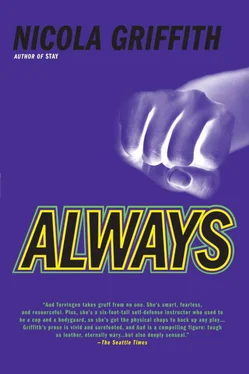“She says she’s from Atlantis,” Henry said helpfully.
—but then I remembered a woman with blond hair talking about cameras and falling and—
LESSON 3
ALL TEN WOMEN WERE DAMP-SKINNED. OUTSIDE IT WAS IN THE HIGH FORTIESbut the repaired thermostat was clearly set by people upstairs who weren’t doing much in the way of exercise. I’d shown my class the axe kick, a coup de grâce delivered with the heel and used to break the spine when your assailant was down—though none of them, of course, had really understood the implications of that; I was just showing them how to kick a bag—and the side kick, which used the edge of the foot like a guillotine and was perfect for either neatly displacing the kneecap or more messily wrecking all the ligaments that hold the knee joint together, depending on the angle of attack.
The bag, which I’d unhooked for the exercise and rested end-up on the floor, sagged sadly at knee height. Therese and Kim were braced against it while Katherine let loose a good one.
“Again,” I said. “You might not be accurate with the first kick. Always keep kicking. Once is almost never enough.” She whomped it again. “And once more, this time with some noise. Use your lungs. They’re like bellows, pumping oxygen. Fuel for your fire.”
This time when she kicked she squeaked like a furious guinea pig, a sound that at least had the startle factor in its favor.
“Good, thank you. These kicks are what you use when you are in a serious fight, when you have to put them down long enough to get away.”
“How long is that for?” Katherine said, breathing hard. She kept eyeing the bag as though willing it to straighten up and act threatening so that she could kick it again.
I looked at the class. “How long do you think?”
“It depends,” they chorused.
“Exactly. Long enough to ensure your safety, whatever it takes. And every situation will be different. Let’s say you’re in the parking lot at Kroger. How long then?”
“Two minutes?” Jennifer said.
Tonya shook her head. “It doesn’t matter how long, just as long as you’ve got the time to get to your car.”
And get in and lock the doors.
“Or maybe just long enough to get back into the store and get help,” said Therese.
“Also good. Now, what about being in Piedmont Park at night? Suze?”
“It would have to be longer, because it’s a big park, and it’s dark.”
“How long do you think?”
“If you were in the middle of the park? Twenty minutes. It would take about that to get to the lights, and people.”
“That’s on a normal day. If you’re hurt or in shock, you won’t be thinking clearly or moving fast. You’ll need even more time.”
“Or you could call nine-one-one and hide,” Christie said.
“Calling nine-one-one is a good idea no matter what,” I said. “But just because you call doesn’t mean they come. To be safe you take them down long enough for you to reach safety.”
They thought about that for a bit. Tonya was the first to see where it was heading.
“Twenty or thirty minutes is a real long time….”
And now Therese was folding her arms: she saw where we were going, too, and she didn’t like it one bit.
I nodded. “Sometimes the only way to survive is to disable your attacker, not just hurt them. Hurting them makes them not want to run after you, but disabling them means making sure they can’t.”
No one said anything.
“In this kind of extreme case, you go for the eye, the knee, or the throat. Eyes, because if they can’t see you, they can’t find you. Knee, because they can’t chase you if a leg doesn’t work. Windpipe, because if they can’t breathe they can’t do anything.”
Compromise oxygen supply, structural integrity, or visual acquisition of the target—though Jennifer, of course, might want to know how you’d deal with a blind attacker who was already used to following people they couldn’t see.
Therese tightened her arms and lowered her chin. “If you’re talking about cutting someone’s air supply for twenty minutes while you’re not there, you’re talking about maybe killing them.”
“Yes.” Another way to cut off oxygen would be to cut off its medium of transport, the blood supply—open the carotid, for example—but I imagined she would like that idea even less.
“I can’t believe that would be necessary.”
And that was the problem, mine as well as theirs, because part of me hoped they never had to believe, never came to a personal understanding of the necessity for these techniques.
“Could you kill someone to save yourself?” Therese said.
“Yes.”
“You sound very sure.”
“If you decide to hurt someone to save yourself, you need to commit to it completely.”
“Do or don’t do, there is no try,” Nina said in a Yoda voice.
“Something like that,” I said over the nervous laughter. “But about whether or not learning this is necessary, think of all the other things you learn that you’ll probably never need. Like fire drills. It’s unlikely that you’ll ever need to scramble from your workplace at three in the afternoon because of a massive fire, but you learn the procedure just in case.” But fires weren’t directed personally at their target, they didn’t sneer and call you bitch, and if you got burnt, your friends didn’t think it was your fault. Women weren’t reared from infancy to fear fire.
“So,” I said, “the knee, the eye, the throat. The knee is a good target, difficult to protect against one of those kicks we just learnt. The eye is extremely vulnerable.” Tonya made a pecking motion. “The throat is more complicated. There are two targets. The larynx, or voice box, which you can feel if you tilt your head up and run your finger down your windpipe until you feel a bump, your Adam’s apple. No, higher up than that, Christie. Kim, would you show her—about where her mole is, yes. It’s easier to find on a man. If you hit that bump hard it will fracture and swell. The windpipe closes.”
“Sounds easy enough,” Pauletta said.
“It is.”
Easy did not mean fast or clean. Suffocation takes minutes, and when the victim clutches at his swelling throat it grates, like a knife point dragging along a brick wall.
“It sounds easy, but how many of you think you could do it?”
They looked at one another.
“You need to know you can do it. You need to know it will work. We ended last week with Christie saying that feminine means vulnerable. And that’s what we’re told, yes, but here’s a question. If an average man attacks a woman, intending to rape her, what do you think will happen if she struggles?”
“It’ll just make things worse,” Jennifer said. “He’ll get mad and hurt you worse.”
“No, not according to Justice Department statistics. Their latest available figures say that women fight off unarmed rapists successfully seventy-two percent of the time.”
They were quiet.
“But what if he has a knife?” Jennifer again.
“Then she’ll fight him off fifty-eight percent of the time.”
“A gun?”
“Fifty-one percent.”
“More than fifty percent, even with a gun?”
“Even with a gun. Government statistics.” The media wouldn’t say that, though, because fear is what sells papers and commercial spots. “And we’re talking about untrained, unarmed women. Even before you set foot in this class the odds were in your favor: if you fight back, you’ll probably win. Most stranger attackers, even serious ones who have planned their attack extensively, rely on the attack being fast and quiet. An attacker will watch you: read your body language. Depending on the situation they will test you, to see how easy you’ll be: they’ll spin some story about needing your help. They’ll flatter you, flirt with you. They imply that you’re being unreasonable or not nice or impolite or illogical. You have been brought up— programmed, if you like—to respond to these suggestions.”
Читать дальше












